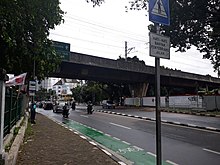
Diah Permata Megawati Setiawati Sukarnoputri is an Indonesian politician who served as the fifth president of Indonesia from 2001 to 2004. She previously served as the eighth vice president from 1999 to 2001.

The Indonesian Democratic Party of Struggle is a centre to centre-left secular-nationalist political party in Indonesia. Since 2014, it has been the ruling and largest party in the House of Representatives (DPR), having secured 128 seats in the last election. The party is led by Megawati Sukarnoputri, who served as the President of Indonesia from 2001 to 2004. It is also the party of the current president, Joko Widodo (Jokowi).
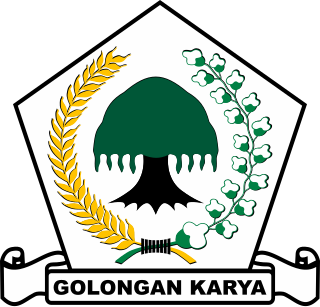
The Party of Functional Groups, often known by its abbreviation Golkar, is a political party in Indonesia. It was founded as the Joint Secretariat of Functional Groups in 1964, and participated for the first time in national elections in 1971 as Functional Groups. Golkar was not officially a political party until 1999, when it was required to become a party in order to contest elections.

The United Development Party is an Islamist political party in Indonesia. Due to its distinctive logo, the party is known as the "Kaaba Party".
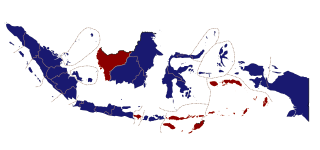
Presidential elections were held in Indonesia on 5 July and 20 September 2004. As no candidate won a majority in the first round, a runoff was held, in which Susilo Bambang Yudhoyono defeated Megawati Sukarnoputri and was elected president. They were the first direct presidential elections in the history of Indonesia; prior to a 2002 amendment to the Constitution of Indonesia, both the president and vice president had been elected by the People's Consultative Assembly (MPR).

Elections in Indonesia have taken place since 1955 to elect a legislature. At a national level, Indonesian people did not elect a head of state – the president – until 2004. Since then, the president is elected for a five-year term, as are the 575-member People's Representative Council, the 136-seat Regional Representative Council, in addition to provincial and municipal legislative councils.

The Indonesian Democratic Party was one of the two state-approved parties during the New Order era of the late 20th-century in Indonesia.

Suharto resigned as President of Indonesia on 21 May 1998 following the collapse of support for his 32-year long presidency. Vice President B. J. Habibie took over the presidency.
The People's Democratic Party was a democratic socialist party in Indonesia.
Legislative elections were held in Indonesia on 29 May 1997. There were three simultaneous elections in one because voters were electing members of two levels of regional government as well as the national-level People's Representative Council. This was to be the last election of President Suharto's New Order regime, which collapsed a year later. Like the preceding New Order elections, it was won outright by the Golkar organization.

Legislative elections were held in Indonesia on 3 July 1971, the first under the New Order regime. There were ten participants; nine political parties and the "functional group" Golkar, which came first with more than 60 percent of the vote, resulting in an absolute majority in the People's Representative Council.

Legislative elections were held in Indonesia on 2 May 1977. They were the third legislative elections since independence, and the second under the New Order regime. There were three participants; the two political parties and functional group Golkar.

Legislative elections were held in Indonesia on 4 May 1982. They were the fourth legislative elections since independence and the third under the New Order regime There were three participants; the two political parties, the United Development Party (PPP), the Indonesian Democratic Party (PDI) and the "functional group" Golkar. As with all elections during the New Order regime, the government-backed Golkar organization won an absolute majority.

Legislative elections were held in Indonesia on 23 April 1987, to elect 400 of the 500 members of the People's Representative Council (DPR), the national legislature. The election was the fifth legislative election in the country since independence and the fourth legislative election under President Suharto's New Order. The election resulted in an outright majority for Golkar, which retained its status as the ruling party of the country.
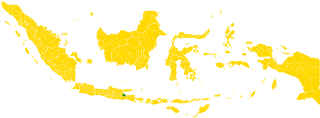
Legislative elections were held in Indonesia on 9 June 1992, to select 400 of the 500 members of the People's Representative Council (DPR). The election was the sixth legislative elections since Indonesian independence and the fifth legislative elections under the New Order regime of president Suharto. The election resulted in a clear victory for Golkar, which retained its status as the ruling party, although the opposition, under the United Development Party (PPP) and the Indonesian Democratic Party (PDI), saw their vote shares rise.

Early legislative elections were held in Indonesia on 7 June 1999. They were the first elections since the fall of Suharto and end of the New Order, and the first free elections in Indonesia since 1955. With the ending of restrictions on political activity following the fall of Suharto, a total of 48 parties contested the 462 seats up for election in the People's Representative Council. A further 38 seats were reserved for members of the armed forces.
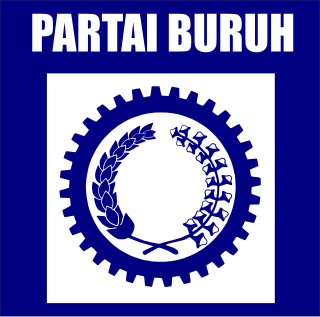
The Labour Party was a political party in Indonesia. It had its origins in the Indonesian Prosperous Laborers organization (SBSI), which in 1993 threw its support behind the Indonesian Democratic Party (PDI) as a vehicle for its political aspirations. When the PDI split in 1996, it allied itself with the breakaway faction led by Megawati Sukarnoputri, which led to it coming under pressure from the New Order government of President Suharto. On 30 July 1996, SBSI chairman Muchtar Pakpahan was detained on subversion charges. Following the fall of Suharto in 1998, the SBSI became disillusions with Megawati's now renamed Indonesian Democratic Party – Struggle and decided to establish its own party, the National Labour Party. After the failure in 1999 election, the party changed its name to Social Democrat Labour Party. The party stood in the 2004 Indonesian legislative election, but won only 0.6 percent of the vote and no legislative seats. Party chairman However, the party has 12 representatives in provincial assemblies. The party subsequently changed its name to the Labour Party.
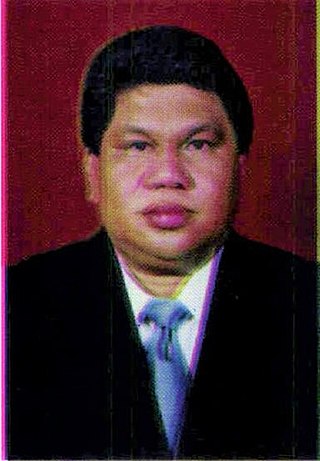
Roy Binilang Bawatanusa Janis was an Indonesian politician who was a member of the People's Representative Council from 1999 until 2005, and was the first chairman of the Democratic Renewal Party.

Suryadi, alternatively spelled as Soerjadi, was an Indonesian politician who served as the chairman of the Indonesian Democratic Party from 1986 until 1998. He became prominent for his faction's involvement in the 27 July 1996 incident, or more commonly known as the Kudatuli incident.
From 20 to 21 October 1999, the People's Consultative Assembly (MPR), the legislative branch of Indonesia, met to elect both the president and vice president of the country for a five-year term. The incumbent president, B. J. Habibie, declined to stand for election. On 20 October, Abdurrahman Wahid, chairman of the Nahdlatul Ulama, was elected president and inaugurated on the same day. Wahid's opponent, Megawati Sukarnoputri was subsequently elected vice president the next day. The elections represented the first relatively democratic and peaceful transfer of power in the history of Indonesia.
